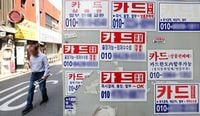The delinquency rate on credit card loans from domestic banks has surged to its highest level in 20 years, reaching 3.8% as of February 2025. This alarming statistic, reported by the Bank of Korea and the Korea Federation of Banks, reflects the growing financial strain faced by many consumers as the economic downturn continues to take its toll.
In the months leading up to this peak, the delinquency rate fluctuated slightly. It stood at 3.4% in both October and November 2024, dipped to 3.1% in December 2024, then rebounded to 3.5% in January 2025 before climbing again in February. This latest figure matches the delinquency rate seen in August 2005 and is the highest since May 2005, when it reached 5.0%.
The increase in delinquency rates is attributed to the prolonged economic recession, which has exacerbated financial difficulties for vulnerable groups. As banks and second-tier financial institutions tighten their lending criteria, many borrowers have turned to credit card loans, which often come with higher interest rates, to meet their immediate financial needs.
According to the Credit Finance Association, the average interest rate for card loans from nine card companies was 14.83% per year as of March 2025, inching closer to the 15% mark. This high interest burden is likely to persist, particularly as rising delinquency rates lead to increased provisioning costs for banks, which could, in turn, drive up card loan interest rates further.
The four major financial holding card companies—KB, Shinhan, Hana, and Woori—have also reported rising delinquency rates. For the first quarter of 2025, their average delinquency rate was 1.81%, a significant increase of 0.28 percentage points from the 1.53% recorded in the fourth quarter of 2024. By individual company, Hana Card reported the highest rate at 2.15%, followed by Woori Card at 1.87%, and both KB Kookmin Card and Shinhan Card at 1.61% each.
This trend raises concerns about the financial stability of many households, particularly those already facing economic challenges. As the reliance on credit card loans increases, the risk of default and further financial strain grows. Experts suggest that the current economic climate, characterized by high inflation and stagnant wages, is contributing to this distress.
The implications of these rising delinquency rates are significant. If borrowers continue to struggle with repayment, it could lead to a cycle of increased borrowing and higher interest rates, further entrenching financial difficulties for those already in precarious situations. Additionally, as banks face higher delinquency rates, they may become even more cautious in their lending practices, potentially limiting access to credit for many consumers.
In light of these developments, financial analysts are urging caution. The current environment poses challenges not only for borrowers but also for financial institutions, which may face increased costs associated with managing delinquent loans. The situation calls for a comprehensive approach to address the underlying economic issues that are driving consumers to rely on high-interest credit card loans.
As the situation evolves, it will be essential for both consumers and financial institutions to navigate these turbulent waters carefully. The need for responsible lending practices and financial education has never been more critical as individuals seek to manage their debts in an increasingly challenging economic landscape.
In summary, the rise in credit card loan delinquency rates to 3.8% is a stark reminder of the ongoing economic challenges faced by many in South Korea. With financial pressures mounting, the reliance on high-interest credit solutions is likely to continue, raising concerns about the long-term financial health of consumers and the stability of the banking system.


